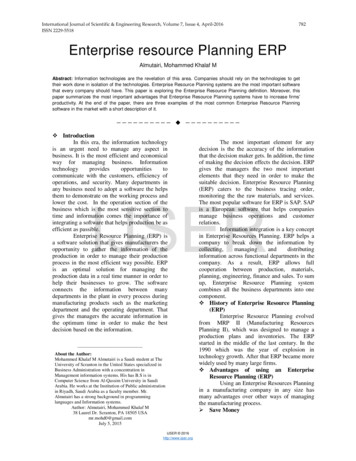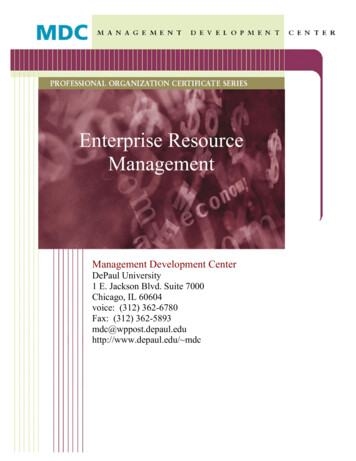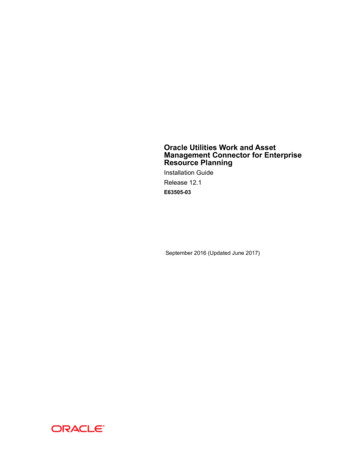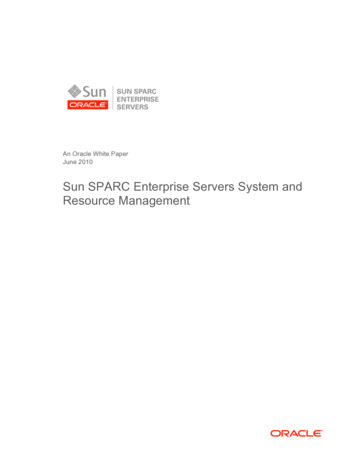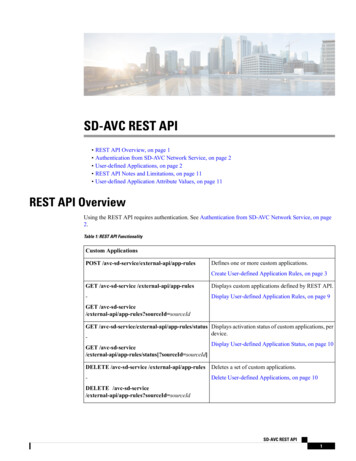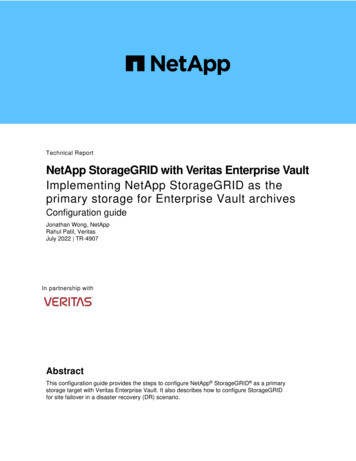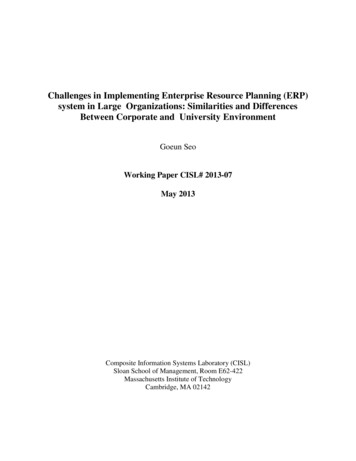
Transcription
Challenges in Implementing Enterprise Resource Planning (ERP)system in Large Organizations: Similarities and DifferencesBetween Corporate and University EnvironmentGoeun SeoWorking Paper CISL# 2013-07May 2013Composite Information Systems Laboratory (CISL)Sloan School of Management, Room E62-422Massachusetts Institute of TechnologyCambridge, MA 02142
Challenges in Implementing Enterprise Resource Planning (ERP) Systemin Large Organizations:Similarities and Differences Between Corporate and University EnvironmentByGoeun SeoB.S. C.S.E., Ewha Womans University, 2003MBA, Sungkyunkwan University, 2013SUBMITTED TO THE MIT SLOAN SCHOOL OF MANAGEMENT INPARTIAL FULFILLMENT OF THE REQUIREMENTS FOR THE DEGREEOFMASTER OF SCIENCE IN MANAGEMENT STUDIESAT THE MASSACHUSETTS INSTITUTE OF TECHNOLOGYJUNE 2013 2013 Goeun Seo. All Rights Reserved.The author hereby grants to MIT permission to reproduce and todistribute publicly paper and electronic copies of this thesis document inwhole or in part in any medium now known or hereafter created.Signature of Author:MIT Sloan School of ManagementMay 10, 2013Certified By:Stuart E. MadnickJohn Norris Maguire Professor of Information Technologies, MIT Sloan School of ManagementAnd Professor of Engineering Systems, MIT School of EngineeringThesis SupervisorAccepted By:Michael A. CusumanoSMR Distinguished Professor of ManagementProgram Director, M.S. in Management Studies ProgramMIT Sloan School of Management
[Page intentionally left blank]2
Challenges in Implementing Enterprise Resource Planning (ERP) Systemin Large Organizations:Similarities and Differences Between Corporate and University EnvironmentByGoeun SeoSubmitted to the MIT Sloan School of Management on May 10, 2013 inpartial fulfillment of the requirements for the degree of Master ofScience in Management StudiesABSTRACTEnterprise resource planning (ERP) system has been one of the most popular business managementsystems, providing benefits of real-time capabilities and seamless communication for business in largeorganizations. However, not all ERP implementations have been successful. Since ERP implementationaffects entire organizations such as process, people, and culture, there are a number of challenges thatcompanies may encounter in implementing ERP systems.Recently, some universities have begun replacing their legacy systems with ERP systems to improvemanagement and administration. This thesis focuses on challenges of ERP implementation betweencorporate and university environment. I review previous studies that determine Critical Successful Factors(CSFs) and risk factors to implement ERP in both environments. Particularly, case studies in this thesisemphasize the organizational dynamics involved in ERP implementation by using CSFs and three phasesof framework by Miles and Huberman (1994): antecedent condition, implementation process, andoutcomes. This study uses findings from the case studies to assess ERP readiness and CSFs’ fulfillment.The results from this study contribute to contextual understanding of distinctive challenges in ERPimplementation between corporate and university environment.Thesis Supervisor: Professor Stuart MadnickTitle: John Norris Maguire Professor of Information Technologies, MIT Sloan School of Managementand Professor of Engineering Systems, School of Engineering3
[Page intentionally left blank]4
AcknowledgementI would like to sincerely express my gratitude to Professor Stuart Madnick for his guidance and advice asmy thesis advisor. He suggested that I connect my past work experience and my educational experience atMIT for my thesis. I am very glad that I was able to incorporate my past experience in pursuit of mythesis. I am very thankful to Mr. Allen Moulton for helping me with the case study interviews and givinga valuable guidance.I also would like to thank all my interviewees: James D. Bruce (MIT), Donna Behner (MIT), KevinLyons (MIT), Bob Casey (MIT), Ken Le Vie (MIT), Mara Fellouris (University of California, SanFrancisco), Jane Wong (University of California, San Francisco), Dave Pagenkopf (University ofWisconsin-Madison), Bob Mayville (University of Wisconsin-Madison), and Derrian Jones (Universityof Wisconsin-Madison ) for sharing their experience in ERP implementation.In addition, I am so thankful to Samsung SDS, my employer, to give a great opportunity and support tostudy at MIT Sloan. I also would like to thank to Chanh Phan and Julia Sargeaunt in the MSMS programoffice for their endless support and heartfelt cares. All the MSMS class of 2013 friends made myexperience more delightful and unique.Lastly, I would like to express my special thanks to my family and friends for their tremendous supportand endless love. This always encouraged and motivated me to be a better person.5
[Page intentionally left blank]6
Table of ContentsList of Figures . 8List of Tables . 81.Introduction . 91.1. ERP in Business. 91.2. Challenges of ERP implementation in Business . 101.3. ERP in Higher Education Institutions (HEIs) . 121.4. Research motivation . 121.5. Thesis Structure . 132.Literature review. 142.1. University context. 142.2. ERP benefits in university . 152.3. The ERP implementation process. 162.4. Challenges of ERP implementation in University . 192.5. Critical Success Factors for ERP implementation . 193.Case Study of MIT ERP Implementation . 233.1. Antecedent Condition . 233.2. Implementation Process . 253.3. Project outcome . 334.Case Study of the global engineering company, ENGCO . 354.1. Antecedent Condition . 354.2. Implementation Process . 364.3. Process Outcome . 395.Discussion. 426.Conclusion . 50Appendix A. Interview Questions . 52References . 537
List of FiguresFigure 1-1. ERP Extension (Abbas, 2011) . 9Figure 1-2. The iron triangle of project management . 11Figure 2-1. ERP benefits in Universities (Sabau et al., 2009) . 16Figure 2-2. Five stage of ERP implementation process (Ehie & Madsen, 2005) . 18Figure 2-3. Taxonomy for ERP critical factors (Al-Mashari et al., 2003). 22Figure 3-1. Stakeholders on MIT . 23Figure 3-2. Stakeholder challenges on MIT to change . 24Figure 3-3. MIT ERP Project Key Milestone . 25Figure 3-4. Vendor evaluation for the ERP system (MIT, 1997) . 26Figure 3-5. MIT SAP Project Team Organization Chart . 27Figure 3-6. MIT ERP System Extension (Kevin Lyons, April 3, 2013) . 30Figure 3-7. Enterprise System Architecture of MIT (MIT, 2004) . 31Figure 3-8. Enterprise System Interfaces of MIT (MIT, 2004) . 32Figure 4-1. ENGCO Organizational Chart, 2003. 36Figure 4-2. ENGCO ERP Project Key Milestone . 36Figure 4-3. ENGCO ERP Project T/F Team Organizational Chart . 37Figure 4-4. Decision support system architecture using OLAP (Chaudhuri, Dayal & Ganti, 2001) . 41List of TablesTable 1–1. Top ten risk factors of ERP risk (Huang et al., 2004). 10Table 4–1. SAP Standard Usage by Modules in ENGCO (%) . 38Table 5–1. Readiness Assessment Rating Framework (Gartner, 2011). 42Table 5–2. The proposed framework of ERP Readiness Assessment (Hanafizadeh & Ravasan, 2011) . 43Table 5–3. ERP Readiness Comparison, MIT and ENGCO . 45Table 5–4. Summary of ERP CSFs fulfillment comparison, MIT and ENGCO . 488
1. Introduction1.1. ERP in BusinessEnterprise Resource Planning (ERP) is a software solution that integrates business functions and data intoa single system to be shared within a company. While ERP originated from manufacturing and productionplanning systems used in the manufacturing industry, ERP expanded its scope in the 1990’s to other"back-office" functions such as human resources, finance and production planning (Swartz & Orgill,2001; Nieuwenhuyse, Boeck, Lambrecht, & Vandaele, 2011). Moreover, in recent years ERP hasincorporated other business extensions such as supply chain management and customer relationshipmanagement to become more competitive (See Figure 1-1 below).Supply (CRM)EnterprisePerformanceManagement(EPM)Human CapitalManagement(HCM)Sales ForceAutomation (SFA)ElectronicCommerce Students Systems&Virtual LearningEnvironmentFigure 1-1. ERP Extension (Abbas, 2011)The major goal of ERP is to increase operating efficiency by improving business processes anddecreasing costs (Nah, Lau, & Kuang 2001; Beheshti 2006). ERP allows different departments withdiverse needs to communicate with each other by sharing the same information in a single system. ERPthus increases cooperation and interaction between all business units in an organization on this basis(Harrison, 2004).Also, ERP standardizes processes and data within an organization with best practices. The company alsostreamlines data flow between different parts of a business by creating a one-transaction system (Lieber,1995). As Hitt, Wu, and Zhou (2002) stated, “the standardized and integrated ERP software environmentprovides a degree of interoperability that was difficult and expensive to achieve with stand-alone, custombuilt systems.” Standardization and integration of processes and data allows a company to centralizeadministrative activities, improves ability to deploy new information system functionality, and reducesinformation system maintenance costs (Siau, 2004).As a result of its benefits, ERP has become the backbone of business intelligence for organizations bygiving managers an integrated view of business processes (Parr & Shanks, 2000; Nash, 2000). ERP isdesigned to adapt to new business demands easily. The continuous technological advancement and theincreasing complexity of ERP require companies to regularly upgrade their systems. Most ERP vendorsprovide an opportunity to update procedures and align with perceived best practices to meet changingbusiness needs more quickly (Harrison, 2004).A significant number of organizations have adopted ERP over the last two decades, and the revenue of the9
ERP market has grown from 17.2 billion in 1998 (O’Leary, 2000) to 39.7 billion in 2011 (Dover, 2012).1.2. Challenges of ERP implementation in BusinessIn spite of ERP’s significant growth from the late 1990s to the present day, there are a number ofchallenges that companies may encounter when implementing ERP.Dillard and Yuthas (2006) stated that most multinational firms are using ERP and that more small andmidsize companies have begun to adopt ERP. Despite ERP’s promises to benefit companies and asubstantial capital investment, not all ERP implementations have successful outcomes. ERPimplementations commonly have delayed an estimated schedule and overrun an initial budget (Ehie &Madsen, 2005; Helo, Anussornnitisarn & Phusavat, 2008).Furthermore, the literature indicates that ERP implementations have sometimes failed to achieve theorganization’s targets and desired outcomes. Much of the research reported that the failure of ERPimplementations was not caused by the ERP software itself, but rather by a high degree of complexityfrom the massive changes ERP causes in organizations (Scott & Vessey, 2000; Helo et al., 2008;Maditinos, Chatzoudes & Tsairidis, 2012).These failures can be explained by the fact that ERP implementation forced companies to follow theprinciple of ‘best practices’ in most successful organizations and form appropriate reference models.(Zornada & Velkavrh, 2005) According to Helo et al., (2008), “Unlike other information systems, themajor problems of ERP implementation are not technologically related issues such as technologicalcomplexity, compatibility, standardization, etc. but mostly [about] organization and human related issueslike resistance to change, organizational culture, incompatible business processes, projectmismanagement, top management commitment, etc.”. Huang, Chang, Li and Lin (2004) presented the topten risk factors causing ERP implementation failure (See Table 1-1 below).PriorityName1Lack of senior manager commitment2Ineffective communications with users3Insufficient training of end-users4Failure to get user support5Lack of effective project management methodology6Attempts to build bridges to legacy applications7Conflicts between user departments8Composition of project team members9Failure to redesign business process10Misunderstanding of change requirementsTable 1-1. Top ten risk factors of ERP risk (Huang et al., 2004)10
These risk factors illustrate various organizational considerations: organization fit, skill mix, projectmanagement and control, software system design, user involvement and training, and technologyplanning.Since ERP implementation inevitably causes organizational changes, it requires the engagement of seniormanagement from across the organization who is able to resolve conflicts. Without the commitment ofsenior management, ERP implementation has a high risk of failure.In other words, due to changes in business processes across an organization, there can be resistance toadopting the ERP system. ERP connects and integrates all business functions within the organization.Therefore, it is critical that management staff be committed, and particularly that they equip employeeswho are using business functions influenced by ERP with clear channels of communication. Lack of enduser training increases risks by creating confusion and inaccuracy, thereby decreasing user satisfactionand the credibility of the system.Excellent project management is also needed for successful ERP implementation. Project teams shouldhave clear guidelines to execute ERP implementation from their project objectives and work plan to theirresource allocation plan. Without good project management, ERP implementation projects that are largein scale and must take place over longer time periods may end in failure.Furthermore, the composition of team members plays a crucial role in ERP implementation. ERPintegrates diverse business functions across an organization into one single system, necessitating acomplex and integrated software package. If a project team does not clearly understand the changes in itsorganizational structure, strategies, and processes from ERP implementation, it will not be in a position tobenefit from ERP’s competitive advantage. In order to best implement ERP, project team members shouldbe selected with a balance between members with business experience within the organization andexternal experts with specialties in ERP.From the perspective of project management, the iron triangle can illustrate how important it is to balancethe three corners of the triangle – scope, schedule and cost. (Lamers, 2002)ScopeCostScheduleFigure 1-2. The iron triangle of project management (Lamers, 2002)However, in ERP implementations, both schedule and cost tend to be underestimated, while scope isoverestimated (Aiken, 2002). ERP changes the entire organizational environment by reengineering theentire business process; thus, after implementation, it is not easy to revise previous processes. Therefore,ERP implementations need accurate estimation, preparation with a holistic view, and systematicmanagement of the entire implementation process.11
1.3. ERP in Higher Education Institutions (HEIs)Despite the challenges of implementing ERP systems, organizations in the corporate sector, which likelyoperate in more financially competitive environments than those in the non-profit sector, haveexperienced numerous benefits from ERP systems during the last two decades. These successes haveencouraged higher education institutions (HEIs) to adopt ERP systems with the same goals that promotedcorporate sector adoption (Fisher, 2006) such as increasing operational efficiency and decreasing costs.HEIs have made significant investments in ERP implementation to improve institutional businessprocesses (Mehlinger, 2006). According to Abugabah and Sanzogni (2010), HEIs spent more than 5billions in ERP investment during the last few years. Recently, ERP vendors have expanded their productscope to include new products in response to relatively new market needs. Examples of such productsinclude student lifecycle management software from ORACLE and SAP.In spite of these additions, the implementation of ERP systems in HEIs has been described as challenging.(Rabaa’i, Bandara & Gable, 2009) One study found that in 60 to 80 percent of higher education contexts,ERP implementation failed to meet expected outcomes and results of implementation were foundunsatisfactory (Mehlinger, 2006). ERP was initially designed for corporate organizations. Although ERPprovides numerous customization options, these options may increase the risk of failure by increasing thescope of work and cost of implementation, as well as delaying implementation schedules.Also, Pollock and Cornford (2004) described that ERP implementations create tension and affect theidentity of universities raising new organizational issues based on the perceived uniqueness of specificuniversities, an issue that will be discussed later. Feemster (2000) described the difficulties experiencedwith an ERP system implementation in a U.S. college as “merging a system of decades– old databasesand re-educating campus employees” and causing “enormous cost and pain”.HEIs have considered ERP adoption as a method of achieving greater integration of their managementsystems to better manage increasingly complex operations (Frantz, 2002). From decreasing governmentfunding to increasing expectation by stakeholders, universities are currently under pressure to deliverhigher quality educational services for lower costs. For these reasons, ERP systems can be very appealingto HEIs as a potential route to meeting these standards.1.4. Research motivationThis thesis is motivated by the increasing adoption rate of ERP systems in HEIs. Even though there havebeen numerous studies about the challenges and critical success factors for ERP implementation in thecorporate sector during the last two decades, HEIs have been reported not getting last-mover advantagesfrom lessons learned in the corporate sector.This study investigates why ERP implementation failures continue to occur within universities1 using acase study of ERP implementations in Massachusetts Institute of Technology (MIT). It compares this caseto another case from the corporate sector to figure out similarities and differences of challenges in ERP1Higher education institutions cover a wide range of institutions- universities, colleges, academies, and institute of technology.(Wikipedia) This study focuses on universities.12
implementation between the corporate sector and HEIs, and attempts to describe key similarities anddifferences of challenges in ERP implementation between the corporate sector and HEIs.1.5. Thesis StructureThe study is structured as follows. First, a brief literature review introduces the university setting, theadoption of ERP systems in HEIs, and benefits and challenges of ERP implementation in HEIs. Thissection also gives ERP implementation process and critical success factors (CSFs) in ERPimplementation. Next, the study conducts two in-depth case studies – one from a university and anotherfrom corporate sector – by following a framework of ERP implementation processes according to Milesand Huberman (1994)’s matrix with antecedent conditions, the implementation process, and outcomes.The cases emphasize different areas in which challenges are most commonly reported, including thedecision of ERP implementation, ERP selection, ERP implementation procedures, Consultantsrelationship, and ERP system evaluation. In subsequent discussion, Assessment of ERP readiness andCSFs fulfillment using the findings from the case studies offer a rich contextual understanding ofcomparative challenges in ERP implementations between these two sectors. Finally, a conclusion sectionsummarizes key findings and makes recommendations for further research and action.13
2. Literature review2.1. University contextA university’s most valuable assets are faculty, students, and staff. Each has distinctive interests withinthe same organization. For faculty, a university is a place to teach, conduct research, and write. Forstudents, it is a place to learn, live, and entertain. For staff, it may share many features with corporatework, including management structure, hours, and HR practices. (Duderstadt, Atkins & Van, 2002)Pollock and Cornford (2004) stated that university is “thought of as a band of scholars coming together inpursuit and dissemination of knowledge, governed by a more or less collegiate model of organization,based around a complex structure of committees and with a high degree of individual and departmentalautonomy”.In this sense, a university has been regarded as a “unique” organization that is different from anorganization in the corporate sector in the literature for several decades (Lockwood & Davies, 1985;Balderston, 1995; Pollock & Cornford, 2004). Studies indicate that we must think of universities as morethan non-profit organizations.According to Lockwood and Davies (1985), universities have a certain combination of uniquecharacteristics: complexity of purpose, limited measurability of outputs, both autonomy and dependencywith regard to wider society, and diffuse structures of authority and internal fragmentation. This particularcombination makes universities “unique”, while general corporations have one or more of thesecomponents (Pollock & Cornford, 2004).“Colleges and universities are organized along the lines of academic and professional disciplines, groupedinto larger units such as a college of arts and sciences or a school of engineering, as well as into smallersubunits such as a department of history or an institute of biotechnology research (Duderstadt et al., 2002,p93).” The parallel structure divided into highly specialized academic units in universities makesdecision-making processes different from those of corporations, which have formal and hierarchicalcommunication structure.On the other hand, there are some fundamental similarities between universities and corporations, andchief among these is that both universities and corporations are facing the common challenges of survivalin competitive environment: increasing needs to improve efficiency and performance in administrativeservices (Allen & Fifield, 1999).Enrollment in degree-granting institutions such as universities in the U.S. increased by 11 percentbetween 1990 and 2000. Between 2000 and 2010, enrollment in degree-granting institutions in the U.S.increased 37 percent, from 15.3 million to 21.0 million. During the same period, the number of full-timestudents rose 45 percent. 2While the number of students in universities has been increasing, rising expectations on the part ofstakeholders (particularly students and the government), quality and performance requirements, and morecompetitive federal and local research funding have encouraged universities to strive for administrativeexcellence and to provide the best opportunities for students to attain competitive advantages (Allen &2U.S. Department of Education, National Center for Education Statistics. (2012). Digest of Education Statistics, 2011 (NCES 2012-001), Chapter3. http://nces.ed.gov/fastfacts/display.asp?id 9814
Kern, 2001; Fisher, 2006; Okunoye, Frolick & Crable, 2006). As a result, in spite of their uniqueness,universities have been forced to adopt certain of the corporate sector best practices for efficiency andproductivity in business.In addition to the competitive environment, rapid advances in information technology have reshapeduniversity administrative practices (Duderstadt et al., 2002). For example, research and scholarshipdepend upon information technology such as virtual laboratories and digital libraries. Also, newtechnology has affected teaching, “freeing the classroom from the constraints of space and time andenriching the learning of our students through access to original source materials” (Duderstadt et al.,2002).Considering the significant influence of information technology in universities, it is not surprising thatmany have adopted ERP systems for development and reengineering of administrative systems as a routeto improved performance (King, 2002; Abugabah & Sanzogni, 2010).2.2. ERP benefits in universityERP use in HEIs integrates administrative functions that have been supported by separate legacy systems3in the past (Zornada & Velkavrh, 2005). Separate legacy systems were “disparate” and have led to“duplicate resources and services” (Allen & Kern, 2001). ERP enables HEIs to consolidate disparate dataand legacy systems and adopt best-of-breed processes and modern technology.As different departments across an institution share an integrated database, end users can access data inreal time. Best-of-breed information technology such as web technologies, mobile phones, and on-lineservices offer additional benefits not only to the administration within an institution, but also to peoplewho constantly interact with the institution – faculty, students, and staff (Murphy, 2004; Zornada &Velkavrh, 2005).According to King (2002), the main advantages of ERP in HEIs are (1) improved information access forplanning and managing the institution, (2) improved services for the faculty, students and staff, (3) lowerbusiness risks, and (4) increased income and decreased expenses due to improved efficiency. Sabau,Munten, Bologa, Bologa and Surcel (2009) provide ERP benefits for universities in terms of business andtechnical point of views (see Figure 2-1 below).3A legacy system refers to an old method, technology, compu
1.1. ERP in Business Enterprise Resource Planning (ERP) is a software solution that integrates business functions and data into a single system to be shared within a company. While ERP originated from manufacturing and production planning systems used in the manufacturing industry, ERP expanded its scope in the 1990's to other

